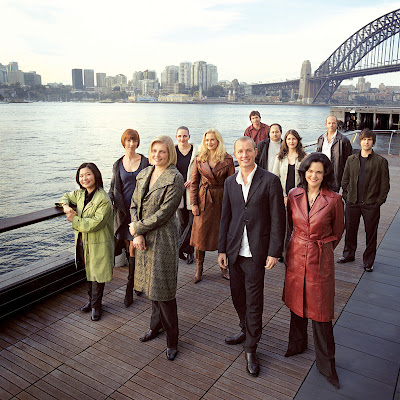In the interest of full disclosure, the author of this article and Ben Folds are distantly related, although they met for the first time on Friday for a brief interview. The author also studied conducting with Sarah Hicks at the Curtis Institute of Music.
 Pianist, singer, and songwriter Ben Folds joined the National Symphony Orchestra Pops to open their 2009-2010 season in an uplifting show conducted by Sarah Hatsuko Hicks. The full house comprised the youngest, most casually dressed audience your reviewer has ever seen in the Kennedy Center Concert Hall, and they let out a cheer when Folds entered the stage under lighting that frequently changed hues. Hicks, who is Assistant Conductor of the Minnesota Orchestra, Staff Conductor at the Curtis Institute of Music, and Folds’s conductor of choice states that “all pop singers say there is nothing like having eighty musicians behind you.”
Pianist, singer, and songwriter Ben Folds joined the National Symphony Orchestra Pops to open their 2009-2010 season in an uplifting show conducted by Sarah Hatsuko Hicks. The full house comprised the youngest, most casually dressed audience your reviewer has ever seen in the Kennedy Center Concert Hall, and they let out a cheer when Folds entered the stage under lighting that frequently changed hues. Hicks, who is Assistant Conductor of the Minnesota Orchestra, Staff Conductor at the Curtis Institute of Music, and Folds’s conductor of choice states that “all pop singers say there is nothing like having eighty musicians behind you.”
The numbers programmed for Folds’s orchestral performances are his well-known songs orchestrated or “charted” by external consultants and performed with the composer singing at the piano. When asked why he does not do his own orchestrations, Folds mentioned that he does “alter smaller string sections” and does “revisions of the orchestral scores -- especially the percussion,” as he studied percussion and piano formally. Responding to a question about whether he had ever pondered writing something specifically for orchestra, Folds responded, “I heard a few things that would be fun to score that could be done. Now I have so much crap to do. When I was younger I used to hear much more.” Folds also said that he hears ideas before “puttering around on the piano” and keeps the evolving song in the original key in which it was first heard in his mind’s ear.
Should the NSO find more avenues to approach Thursday evening’s wonderful audience? Folds says that “if an orchestra acts like a horse and buggy, it will go the way of the horse and buggy.” Hicks, too, is worried about the fate of concert halls and their orchestras given that “classical composers are no longer rock stars as they were in the 19th century.” Folds says that “every generation must find ways to crack the code and be adaptable; great art and music from the 17th century will always be great art and music.” How adaptable are our orchestras? How popular is contemporary classical music when less than fifty people showed up for one such performance earlier this month at the Corcoran Gallery of Art? When thrown a bone and asked if there is anything he would like to say to the classical music world out there, Folds quickly said, “Kiss my ass.” Folds never finished music school for a number of reasons, including his refusal to learn fixed “Do” solfège. He once asked his ear training professor if he could use movable “Do,” the professor made an exception, whereby Folds brilliantly recited his melodic example by singing up and down “Do, Do, Do, Do, Do, Do, Dooooo.”
It was unfortunate that a lot of text was lost due to a microphone that echoed through the room. Regardless, with a smooth, heady voice, Folds offered about fifteen songs without intermission. Some featured his blues-infused piano introductions and tags, one dropped the f-bomb quite often in its chorus refrain about getting enough food at Denny’s, and another had the audience beautifully singing two chords in three parts at certain points in the piece -- Folds rehearsed us before the song and conducted from the stage. A song for his daughter Gracie featured lyrics such as “some day you’ll be a lady, but until then you’ve got to do what I say.” Other earthy lyrics suggested that hope is a “cheat and a tease,” another explored the life of a “textbook hippie man,” and the political in (this is Washington, of course) “Levi Johnston’s Blues,” which contained lyrics that approximated: “Your mother-in-law might be a heartbeat from the Presidency… I’m not getting married!” The show ended with Stephen’s Last Night in Town followed by thunderous applause.













































































